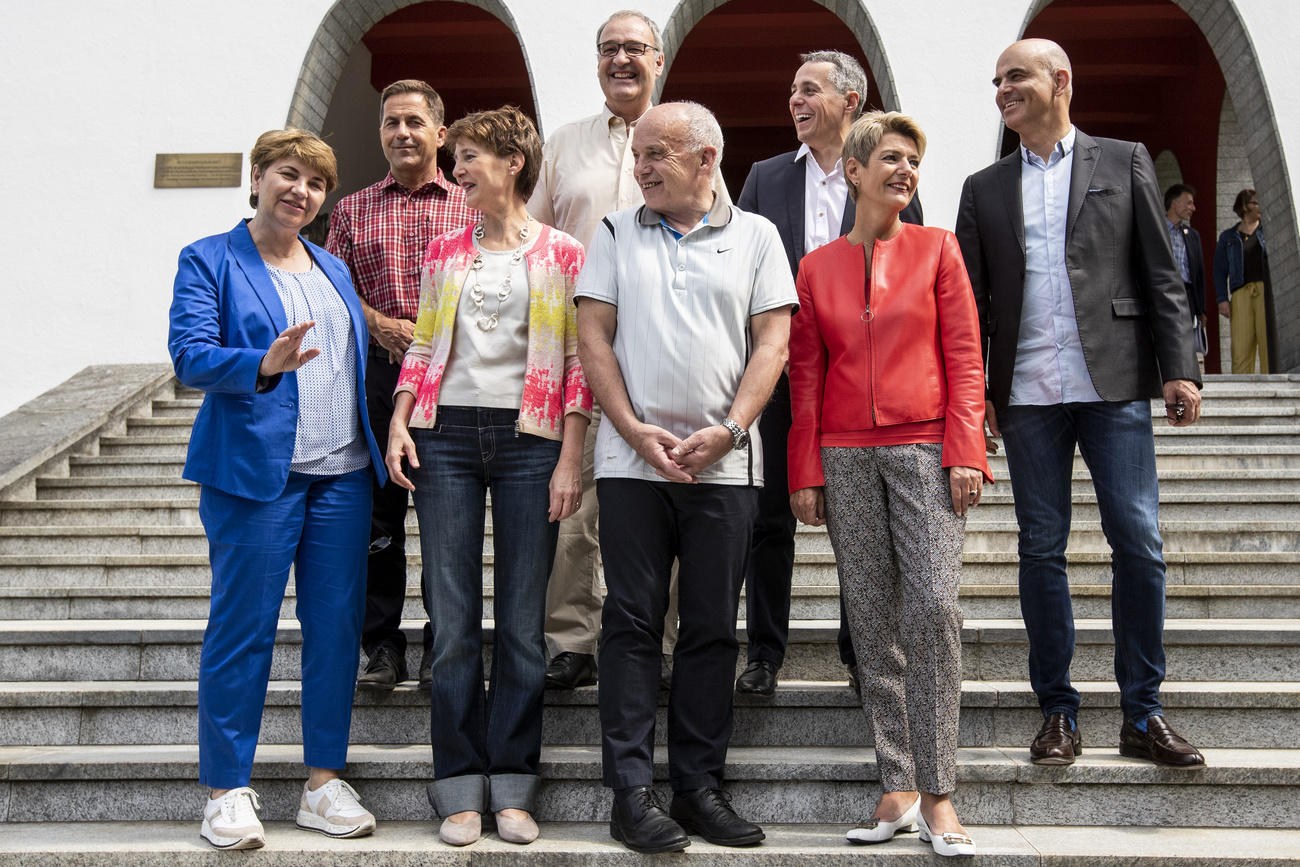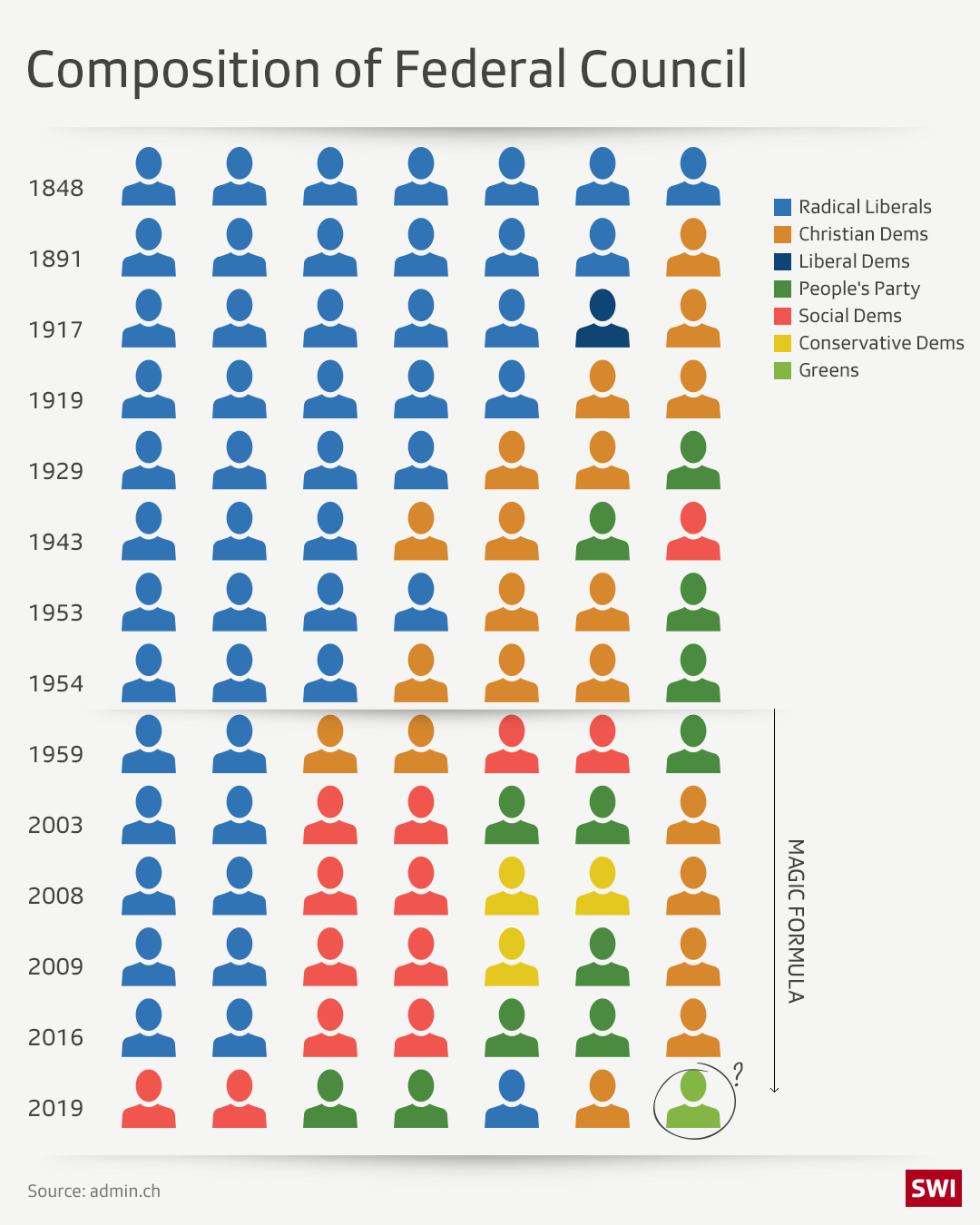
A pluralistic government built on consensus

On Wednesday Switzerland’s new seven-member government will be elected for a four-year term. After the Greens surged in recent elections, there has been much talk about a cabinet reshuffle. Here is a historical look at issues affecting the multi-party government.
The seven-member executive is neither a majority nor a coalition government in the strict political sense. The Swiss cabinet is rather a pluralistic aggregation reflecting a will to reach compromises and to maintain the stability of the direct democracy system.
The current political mix of the Federal CouncilExternal link is the result of a long, slow process of integration. The strength of a political group is a determining factor – although not the sole factor – behind the attribution of a government seat. Strength is based on parliamentary representation and the ability to form majorities during popular votes.
This 2015 video explains how the seven seats on the Federal CouncilExternal link are divided up between the different parties under the so-called ‘magic formula’.
A brief reminder of the unique characteristics of the Federal Council and the Swiss political system:
The Swiss government is a collegial body in which all seven members have the same rights and powers. In Switzerland there is no head of government or head of state. And there are no motions of censure or votes of confidence against members.
Each government member is responsible for a ministry. But important decisions are taken jointly by the cabinet, which meets once a week to discuss issues and to vote behind closed doors. Each draft bill or project that a minister wants to submit to parliament must first gain a majority in the Federal Council. The cabinet then transmits a final approved dossier to parliament for its consideration.
Cabinet members must always seek compromises. This is an essential element of the Swiss political decision-making system, known as a concordance system of democracyExternal link (French).
The main interest for this structure of government is that all the main parliamentary parties (or most) are represented more or less proportionally according to their electoral weighting.
Thus, any cabinet proposal has much more chance of gaining the support of parliament. Once this step has been reached, there are fewer risks that the proposal will be challenged by a referendum or, if successful, rejected by a vote.
This is a crucial point, which distinguishes the Swiss government from representative democracies. The Federal Council is elected by parliament. But the Swiss people, even if they do not choose the ministers, hold great influence over their decisions. Beyond a majority in parliament, the government must convince much wider circles of people.
This has dictated political calculations that have progressively transformed the cabinet since its modern-day creation. In 1848 the Radicals held a complete majority and occupied all seven government seats. They also had no reason to fear being challenged in referendums or popular initiatives, as they didn’t exist at federal level at the time. These instruments of direct democracy were later introduced. The Radicals’ domination ended with the emergence of the proportional system and from 1959 the government integrated the four main political parties.
The political equation to divide up the seven cabinet seats between the main parties is known in Switzerland as the ‘magic formula’. The cabinet has been divided between the four main parties, with the exception of the 2007-2015 period. In recent years, the centre-right Christian Democrats and the right-wing Swiss People’s Party have swapped cabinet seats. As it gained in popularity, the People’s Party claimed two seats, while the Christian Democrats lost one. The centre-right Radicals and the left-wing Social Democrats have each held onto two seats.
The Green Party, which made historic gains in the October 2019 parliamentary elections, is now challenging the current party-political make-up of the cabinet. The left-wing party won 13% of the vote for the House of Representatives – up nearly 6% on 2015 and their best result ever. But a cabinet seat might not become available straight away as in Swiss political culture, changes take time, as the graph shows below.

Translated from French by Simon Bradley

In compliance with the JTI standards
More: SWI swissinfo.ch certified by the Journalism Trust Initiative































You can find an overview of ongoing debates with our journalists here . Please join us!
If you want to start a conversation about a topic raised in this article or want to report factual errors, email us at english@swissinfo.ch.